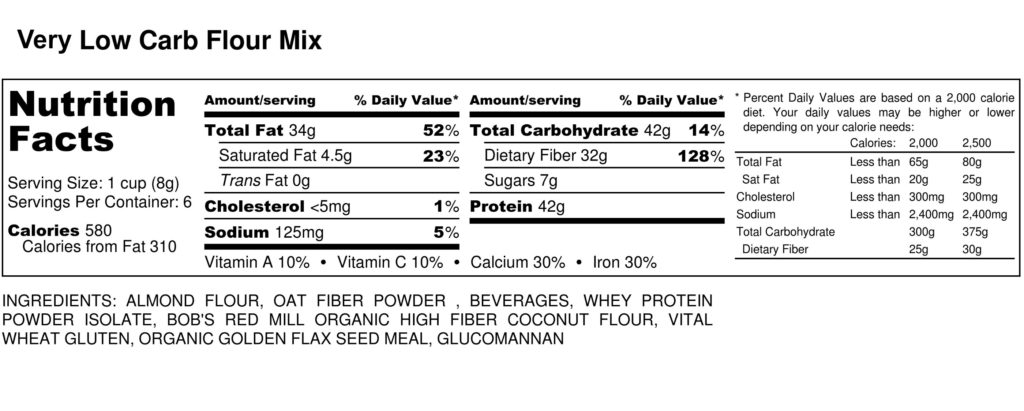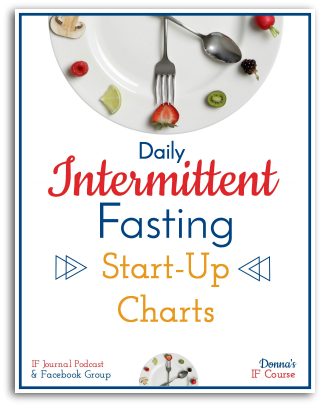When I first began low carb baking seriously three years ago, I had way more failures than I did successes. No one flour seemed to make anything edible—especially for my sons and husband.
Almond flour was too heavy. I didn’t understand how much liquid/how many eggs to use with coconut flour—plus the texture was just off when I followed recipes using solely coconut flour. Don’t even get me started on the recipes I tried using straight flax or oat fiber.
Then I started reading about low carbers who were having success at combining non-grain flours. Caroline, from All Day I Dream About Food, and other healthy recipe bloggers used two thirds to three fourths almond flour and the remainder of coconut flour quite often in recipes.
Other low carbers had various combinations—and some were even in mix form (that you mix up and use cup-for-cup in place of regular flour). This appealed to me because I have been a “make a mix” cook for many years (starting twenty-five years ago this summer with the book Make a Mix Cookery).
Thus, I began a quest to combine low carb flours into a baking mix that my family would eat—and that didn’t taste so “off.” (I also began making various low carb mixes—cake mix, brownie mix, “Bisquick,” bbq base, cream cheese dessert base, and so on.
I have probably tried over twenty different variations in the past three years or so. I had tried putting in some “gluten free” flours (that bake more like white wheat flour) and oat flour—both in an effort to dilute the low carb-not-real-flours. The results were better tasting, but the carb count was a little high.
I then came to the conclusion that I needed a basic flour combination that I could live with—and then mix it with oat flour, sprouted wheat flour, and/or gluten free blends to get a more normal taste when I am baking for my kids.
I have since developed a Sprouted Flour Mix recipe that I use in yeast baking (yes, with low carb rolls and breads at five to eight net carbs each!!!)—and that I combine with this mix to get that more “normal” taste for times that I want healthy and fairly low carb but I want someone besides me to eat it! 🙂
(See my article, “The Power of Dilution,” here.)
I know that I will get asked if you can sub this or that—and you can. The combination is up to you and is dependent upon your budget, the availability of products, your family’s taste, and even your carb “budget.” I have put the approximate carb count of the products that I use in this mixture in parentheses.
I will say, though, that if you can bite the bullet and buy the products and make it one time, you will have the products for refills of the mix over and over since it uses small amounts of various things and since it is a bulk mix (makes a lot). (Then I recommend buying the products one at a time each month or however often you order or go to stores carrying the products, so that it will not feel overwhelming to continue making the mix cost-wise.)
I first published this on my homeschooling/parenting blog (Character Ink Press), and it is by far my most popular recipe. I have had many people write in telling me that after trying many low carb flour mixes, they tried this one and had great results. People often say that it acts the most like “regular flour” than any combination they have used!
General Guidelines for Substitutions:
(1) Obviously, any substitutions will potentially alter the final outcome of a recipe and the taste (at least from what my recipe tester and I got when we made it just as is). Keep that in mind when using substitutions.
(2) If you want to keep the mix super low carb (as it is written), be sure to substitute products with the same or similar carb count. (For example, oat fiber has a zero carb net count so if you substitute oat flour {at approximately eighty carbs per cup} for oat fiber, the carbohydrate total will be MUCH higher than a version with oat fiber.)
(3) You can also double some of the flours that have the same count and omit one. This would make fewer number of total products to buy, but you are going to miss a little bit of the dilution factor if you do not care for the taste of any one single flour.
(4) If you are making substitutions, I would be careful that the coconut flour is not more than twenty-five percent of the total mix since it requires much more moisture (especially eggs) in order to bake with it straight up. Your baked goods might be too dry with too much coconut flour.
(5) I gave a few suggestions in the recipe to help you with substitutions. If you are trying to just buy a couple of things to start with, you could do a combination of ½ almond flour, ¼ coconut flour, and ¼ oat fiber and then grow from there as your budget allows.
So….here is the final version (!). I will link recipes to this Very Low Carb Mix as I put them up.
Also, remember to watch for the e-book containing this mix!! It will likely follow Sugar-Free Solutions; Healthy Mixes: Sugar-Free, Flour-Free; Healthy Mixes: Cream Cheese Dessert Base. It will be called Healthy Mixes: Two Healthy Flour Mixes (Sprouted Flour Mix and Very Low Carb Flour Mix).
This blog is an incremental blog—if you start with the first e-book and move through them, you will learn how to cook and bake with healthy sugar-free substitutes, then flourless baking and candy making, then flour mixes, etc.—all from a curriculum author of seventy books totaling fifty thousand pages who loves to teach incrementally!
Thank-you for joining me!
Note: Given carb counts are from the products that I used and are all net carbs—total carbs minus fiber.
Download my Low Carb Flour Chart, complete with carb counts for many different kinds of low-carb flours!
Below are links to the ingredients I use in this recipe. I am an affiliate for Amazon.com. If you click on the links below I will earn a small commission. Thank you for your support of this blog!
- 3 cups almond flour (12 net carbs per cup–TOTAL 36)
- 1 cup coconut flour (24 net carbs per cup–TOTAL 24)
- ½ cup oat fiber OR ground golden flax (0 net carbs per cup–TOTAL 0)
- ½ cup vital wheat gluten (OR if you do not want gluten in your mix, use 1 / 8* cup Xantham Gum; I love putting gluten in my low carb baked goods) (24 net carbs per cup–TOTAL 12)
- Optional: ½ cup plain whey protein powder (OR may be omitted or just increase almond flour) (16 net carbs per cup–TOTAL 8)
- Note: Carb counts vary among products. For example, some gluten free flours have 110 carbs per cup, while Bob’s Red Mill Gluten Free Flour has eighty! Be sure to check carb counts on various products!
- Makes approximately six total cups. Each cup has approximately 12 NET carbs in it.
- Combine all ingredients thoroughly.
- Store in an airtight container.
While this Basic Flour Mix can be used in place of almond flour alone or in place of any flours in a recipe (can be used to replace almond flour, coconut flour, and whey protein, for example, in a recipe that has all three of those items), here are a couple of my recipes to get you started using this mix:
1. Low Carb Crepes
2. Chicken Noodle Soup
3. BEST Low Carb Biscuits

Recipe Keys
Low Carb (VLC): This is about as low carb of a mixture that you will get in low carb baking (except for straight up flax or oat fiber). You could get approximately the same carb count with almond flour alone, but I don’t like feeding us huge handfuls of nuts over and over again every time we eat any baked good. (I know the low carb high fat people say it doesn’t matter, but it feels like it matters!) I also like the “dilution factor” of using multiple non-grain flours in a mix.
Family Friendly (FF): Again, to make this more Family-Friendly—or to just create a healthier baking mix for your family that is not reliant on processed or over-consumed white flour and other grains, you can do a couple of things: (1) Make this as it is listed and use it half and half with oat flour, quinoa flour, sprouted wheat, or other higher-carb flours that bake up more like regular grains; (2) Make this almost as it is given but use a higher carb flour for any of the really low ones. For example, if you use Bob’s Red Mill Oat Flour or sprouted white wheat flour for some of the flours, you can still end up with a forty-carb-per-cup mix that is healthy as opposed to a one-hundred-carb-per-cup grain (white or wheat flour) that is less healthy. Family-Friendly Low Carbing is a very healthy approach to baking! (3) Make this as is and use it combined with my Sprouted Flour Mix as needed to “dilute” the tastes.
Store-Bought-Stella (SBS): While this is not an SBS model, it is that mindset—get something you can use easily and quickly later so that you don’t have to spend so much time mixing flours, getting out various products all at once, etc. Make the mix once (or double it!), and you have a “homemade convenience food.”
Homemade Hannah (HH): This is very homemade! You can make this completely whole-foods as written above. Coming from a HH background myself (out of necessity of cooking for a family of nine on one income), I adore mixes and always have. If you are a HH who has never used mixes, keep following this blog. You will love what is coming up!
Freezer Cooking (FC): This isn’t in my monthly freezer entrees since it really isn’t an entrée; however, you can make up a double batch and store one in your pantry for everyday use and put one batch in the freezer for later.
Trim Healthy Mama-Friendly (THM) (www.trimhealthymama.com): This is an S baking mix as it is written due to the heavy almond flour amount. However, it could easily be made into a Fuel Pull or an E mix by reducing the amount of almond flour. For the FP, you would reduce the amount of almond flour and replace it with oat fiber. For the E mix, you would reduce the amount of almond flour and replace it with oat flour or sprouted wheat flour. Easy peasy! Also, like the suggestions above for the Family-Friendly folks, you could make it as it is listed and then use half and half—half Basic Low Carb Flour Mix and half oat fiber for FP OR half Basic Low Carb Flour Mix and half oat flour or sprouted wheat for E mix. (I do not do much FP or E baking, but I would make this mix as is and then combine it with Sprouted Flour Mix anytime you want to make an E baked good. Easy peasy!)
Sugar Free (SF): Sugar-free!
Gluten Free (GF): This can definitely be gluten-free if you do not add the gluten and you are sure your oat fiber is completely gluten free. Again, just like the Family-Friendly and the THM E mix options given above, if you are not after low carb but simply after healthier and gluten-free baking options, you may omit the lower carb flours (oat fiber, golden flax, etc.) and use part oat flour or part gluten-free flour. (Bob’s Red Mill Gluten-Free Flour is the lowest carb gluten-free flour I have found—by many carbs in some cases!) Also, you can do the option of making it as is and using half Basic Low Carb Flour Mix and half gluten-free flour for a healthier alternative to just gluten-free flour (which is often made with corn starch, rice flour, and other “white” flours).














You didn’t specify whether the flax seeds are ground or not. Should they be? Because the measurements are a big difference between the two. TIA.
So sorry! We will fix that. It should be ground. I am sure regular ground would also work, but I like the golden as it blends in well and keeps the regular “flour” look. It feels lighter to me as well.
You say in your notes that if you substitute Xantham gym for vital wheat gluten you need to use 1/2 as much of XG for VWG
So this means your Very Lowe carb flour mix would read
Either 1/2 cup of VWG
Or 1/4 cup of xantham gum
Please verify this for me thanks
Rose
What happened to the recipe that was on here 2 months ago? this one is different. if I remember correctly,it had a small amount of xanthan gum and not as much coconut flour.
The one before this one had a few more ingredients. It was thought that fewer ingredients would be better. The differences are that this one does not have golden flax and has gluten OR xantham gum. Not both. Let me know what you think! I’ve been using this one with great success!
You have an error either in the recipe in the note next to the asterisk. You say “*Xantham Gum: I previously forgot to put this in the recipe. If you substitute Xantham Gum for the Vital Wheat Gluten, you need to use half as much of it as the gluten. Sorry for the inconvenience!”. But in the recipe it says to substitute 1/8 cup xantham gum for 1/2 cup of vital wheat gluten. That is 1/4 as much, not half as much.
Hi Donna,
I was looking over the sprouted flour mix recipe and this one. I noted that your nutritional info for Vital Wheat Gluten is quite different between the two recipes. In this one, the info states 24 carbs/1 cup. But on the sprouted flour mix recipe, it says 6 carbs/1 cup. From the info I’ve seen both locally and online, I think it’s somewhere in between. But that likely will affect the total info for your completed recipes on both recipes. This one should be a little lower. Hope that’s not too presumptuous. You’ve done such an amazing job!
I’m excited to try the mix. Such a great time-saving idea and might even encourage me to try converting a couple of my fav recipes to low-carb! I’m looking at ways to reduce the almond flour a bit more because, like you, I try to reduce the percentage of nut flour in recipes – helps reduce the calories and ups the fiber which is always great. Looks like you recommend swapping for more oat fiber or perhaps a mix of oat fiber and ground golden flax seed. Do you recommend a little xanthan gum if I do use the vital wheat gluten. Not the full amount of 1/8c for the recipe, I just wondered if a couple of teaspoons might help the mix at all (furthering the dilution principal). If you have any more updates or suggestions as time has passed, please let us know them. Thanks so much for all of your work on these!
I made this recipe exactly as written, and tried making GF waffles with it. The mix was way too gelatinous, and while tasted good, the center of my waffles did not cook, even with the waffle maker on lowest cooking setting. I’m frustrated to have wasted all the ingredients for that recipe. I feel like your mix has too much xantham gum in it.
I have never tested it in waffles as we are not big waffle fans. I have used it extensively in crepes, and it works great. After I read your comment, I tested it in pancakes, and here are some things I learned:
1) The batter must be way thicker than regular pancake batter (if you are adapting a regular pancake recipe).
2) The batter needs to rest for five to ten minutes before cooking the pancakes.
3) More eggs are needed. Yes, the mix has a small amount of coconut flour, but it still absorbs liquid. I used 4 eggs with 3 cups of baking mix and 2 cups of “buttermilk.” (I’ll post the recipe at the blog this week.)
4) You have to cook them a long time on the first side in order to be able to flip them….way longer than any other pancakes I made with “Bisquick” many years ago. Not just bubbles on the top side but truly browned on the underside and very cooked.
Sorry about your waffles. I understand that for sure. Four years of recipe testing has left me very disappointed at times….still working on that! 🙂
Donna the problem about using that much xantham gum in a recipe for gluten free is the problem. Usually when using xantham gum in a flour mix the general rule is 1 tsp per cup of flour or starch in the mix. so for this recipe there should only be 4 tsp of xantham gum not the 1/4 cup ( 4 Tbls) you call for. It should give you a less gelatinous texture and a much better taste. Another possibility to use instead of the xantham would be to use Psyllium husk powder. Hope this helps someone who might be finding it hard ro bake with the gluten free mix as written, try lowering the xantham gum to the levels I suggested.
Thanks. I tested it more and adjusted. i really appreciate your input!
Just to be sure about the xanthan gum amount; according to Doris, there should be 4 tsp in the total mix but the recipe is showing 1/8 cup is that the amount tested or should the recipe read 4 tsp?
This is all new to me….When the recipe calls for multiple flours in different amounts how can this mix be used…
Catherien,
Have you tried adding more of the other ingredients minus vital wheat gluten/xanthan gum to ‘dilute’ the excessive stickiness? I’m looking to make waffles with this mix and was wondering about using half the gluten/xanthan gum than is called for.
I have noticed this discrepancy with the xantham gum also. I would like to try using this mix but would like to know if I should add 1/8 cup or 1/4 cup? Please clarify. Thank you!!
One huge problem with this . . . Gluten is labelled protein, but acts like carbohydrate. Did you know it raises blood sugar higher and faster than table sugar does?
It is a carbohydrate for sure (the way it acts). It is why breads are fluffier when it is added. The carb count is included in the mix for the addition of the gluten (if you decide to add it). For those who do not want gluten or can’t have it (or do not want the twelve carbs per mix (approximately 1 carb per cup of the mix from the gluten), you can definitely do the xantham gum and/or omit it. Does that help? I’d love to know more of your thoughts! Thanks!
Can I make bread with this mix?
You can make “quick breads”–or non-yeast breads with it. It does not have enough gluten to make dough rise well. If you see a bread that calls for almond flour or coconut flour (to a certain extent–coconut flour usually requires more eggs), you can often substitute this mix for a lower fat, lower calorie, more diverse-tasting flour. If you are after yeast products, I recommend my Low Carb Sprouted Flour Mix. (Bread and yeast product recipes for that mix are coming soon!)
Hi Donna! If I swap the wheat gluten for Xantham gum is it an exact swap? 1/2 cup vital wheat gluten for 1/2 cup Xantham gum? Just want to be sure. It seems like an awful lot of Xantham gum. Thank you.
~Becki
I am interested to know about the amount of xanthan gum to replace the vital wheat gluten. I have never seen a recipe with so much (if it is 1/2 cup).
Use 1/4 cup Xantham gum to replace the vital wheat gluten. Thanks!
That was a typo. It should be 1/4 cup Xantham gum in place of the Vital Wheat Gluten. Thanks!
I’m now searching for the recipe for those pancakes.
Can you link us up?
Thanks!
~J
Hi,
This sounds really good. I am new to baking bead.
I don’t understand how to use your VVL mix to make bread.
Do you just substitute you mix for any of the “flours” in the recipe?
Thank you for your help
Yeast breads do not turn out too great with almond flour mixtures. Thus,I recommend using my Sprouted Flour Mix for any yeast baking. It is a little carbier than almond flour and coconut flour, but it tastes more “normal.”
I do not use the VLC mix to make yeast breads. I have recipes at the blog for cookies, cupcakes, biscuits, and crepes using this mix. I have dozens of recipes in various stages of testing that use this mix. Some of my favorites are quick breads and muffins and cookies. Cake type recipes (muffins, small loaves of bread, cupcakes, cake, etc.) really turn out well with this mix. Let me know how some other dishes turn out for you! Thanks!
Hi,
Would you have a very good pizza crust using this flour mixture? I am low carbing it and really miss my pizza.
Thank you for your help!!!!!
Wayne
you should experiment with few more stuff like
psyllium..makes the bread more flexible, more spongy + its pure fiber
seasame seed (crushed, i crush by myself)..or pure tehini, also great
adding more cream, cream is fat and protein..dilute the carbs
also, use cocunut flakes, instead of coconut flour, the coconut flour sold in the shop is bad and high carb. thats because they take the coconut flakes, takes out the fat..make from it coconut cream (you can do it too). The leftovers..without the coconut fat, is your high carb coconut flour.
I have a special machine for crashing (100$)..but you can use coffee grinder. make it powdery + you can use coconut flakes flour..mix with cream and sweetener (put in fridge) thats a killer candy.
I experimented some with psyllium, and my family really didn’t like it (and neither did I!). My main goal is to make things taste more normal (at least for a while!), so I am steering away from that for now. I would love to know how you use it and how your family likes it!
Hi Donna!
This is all very interesting and I would like to try your mix. However, I live in the Netherlands and I can’t for the life of me find Oat Fibre here. Wheat Flour is available. I take it BOTH are zero net carbs as they are all fibre, so I’m wondering whether I can sub Wheat Fibre for the Oat Fibre you use.
“Wheat Flour” should of course read “Wheat Fibre”
By wheat fiber, do you mean wheat bran? if so, it could be used interchangeably for the oat fiber with just a couple extra carbs. I would definitely give it a try. It appears way lower in carbs than the other products in the mix, so it will help lower the carb count of the mix in total. Hope it goes well for you!
I am so excited to have found your blog. I have been doing the low carb thing myself to lose weight and get more healthy for 4 months(and it’s working really well). But once I’ve finished losing the weight, I want to maintain a lower carb lifestyle for myself and my family. But by lower, I mean maybe 50-80 net carbs a day. I want to include yeast bread on occasion, beans, etc. But I’ve been looking for a LOWER carb yeast bread. I don’t have any restrictions which would exclude gluten, dairy, meat, nuts, etc. I normally make homemade whole wheat bread for my kids from freshly ground wheat (I grind myself). Do you have any recipes that are lower carb than regular whole wheat bread, but wouldn’t necessarily be low enough to fit a 20-30 net carb/day diet. I find that making changes a little at a time works very well with a family and myself. I’d like to take a regular whole wheat bread and tweak it to lower the carbs without greatly sacrificing taste. Also need to learn more on soaking and sprouting to get past the problem of phytates & other anti-nutrients. I am totally willing to do that. Anything you can share or suggestions of recipes to try greatly appreciated! I’ve tried searching “lower carb yeast whole wheat bread” on google or including the word gluten, then I get all the gluten free vegan recipes and so forth that are really low carb, just no luck until now!
My Low Carb Sprouted Flour Mix is exactly what you are describing! You can make rolls, bread, cinnamon buns, breadsticks, and much more out of it for wayyyy under half the carbs in a regular breads. Keep watching the blog for more of these. The one that is there so far is the Low Carb “Pilsbury Crescent Dough.” You’ll love this dough!
Like several others, I was looking for a good mix to use for waffles. This turned into a thick, rubbery paste that I couldn’t spread on my waffle iron. It wouldn’t cook, even when the outside was burnt. So what CAN I use this mix for? I hate to waste the rest of it, so I’m willing to try other recipes.
I have never made waffles with this mix as we don’t make waffles. However, I would think it would be similar to pancakes, which I have made. Did you use 1/4 cup of Xantham gum? More than this seems to make a pastier batter. When making pancakes, I found that I needed to batter to be way thicker than most pancake batters. I also found that I needed more eggs. As for what else this mix can be used for, I have recipes at the blog for cookies, cupcakes, biscuits, and crepes using this mix. I have dozens of recipes in various stages of testing that use this mix. Some of my favorites are quick breads and muffins and cookies. Cake type recipes (muffins, small loaves of bread, cupcakes, cake, etc.) really turn out well with this mix. Let me know how some other dishes turn out for you! Thanks!
Yes, I did use 1/4 cup xanthan gum, which still seemed like too much. I can’t imagine it making decent pancakes and definitely not crepes.
Maybe quick breads, if I can get enough liquid into it to make it less rubbery. Or I may just throw the batch out and start over, now that I have vital wheat gluten. And I’ll start with a half batch just in case…
I don’t make pancakes often and never waffles, but I have definitely used it for the crepes A LOT. The key to the crepes is that the liquid is super thin–like cake mix, not like brownie mix. The xantham gum is really not a huge amount for the full recipe. It is under 1 TBSP per cup of other dry ingredients. Let me know if you like it better with the wheat gluten. Thanks for writing!
Hi Donna,
I am new to low-carb baking, been doing a lot of research lately and came across your flour mix and find it very interesting. Seems like a great way to cut down on the proportions of almond flour, while trying to more closely replicate the real thing.
I am working on converting a Chocolate chip cookie recipe that calls for 10 oz all purpose flour. That’s a little over two cups, but let’s call it two in this case. If I were to try substituting your “Very Low Carb Flour Mix”, that would add approximately 1/3 cup of coconut flour.
With that in mind, would you recommend adding additional eggs and/or liquid to account for the absorption properties of the coconut flour? Perhaps eggs, egg whites, yogurt, or cream? The original recipe (which calls for two large eggs) has a great balance of crispy/chewy, so I will be trying to approximate that as closely as possible. I know it’s going to take some experimentation, just trying to make an educated guess on the starting point.
Thank you,
Adam
I haven’t had great success converting chocolate chip cookie recipes. I think it’s because my expectations are for the cookies to taste like my daughter’s perfect, sugary-white=flour-amazing ones. And it just doesn’t happen. I do have my peanut butter cookie recipes up, and I put chocolate chips in those sometimes. Back to your question with the coconut flour. I expected to have to tweak recipes a lot more for the small amount of coconut flour in this mix, but it hasn’t been the case. Sometimes I add a little extra almond milk, but I haven’t had to increase the eggs like I thought I would have to. That said, I would start with your regular amounts and play with the dough and see. Another egg might be needed. I will be surprised if you get the original crispy/chewy texture, but please let me know if you do!!! 🙂
Thanks Donna. I may be a little over-optimistic, but will give it a shot, and will let you know if I achieve any success. I’ll definitely check out your peanut butter cookie recipe as well.
Do you happen to have any recommendations on what to use to make up the bulk from the omitted white and/or brown sugar? When starting with a concentrated sweetener (such as stevia or monk fruit extract), I’ve seen recommendations for adding egg whites, yogurt, or oat fiber, but have no real insight as to what may work best.
Thanks again,
Adam
If you’re willing to use sugar alcohols, those solve the problem of missing bulk. I use a mix of 4oz xylitol, 3oz erythritol, & 1/2 tsp concentrated stevia powder (NOW brand) and it replaces 1:1 for sugar. Then for brown sugar, you take that and mix it with molasses or black strap molasses (I think 1TBSP per cup) plus maple or rum or butter extract to taste. Just mix with a fork until it’s well mixed and it will come pretty close. Hope that helps.
Or this website also has a recipe to make home-made Pyure which is erythritol mixed with stevia to make twice the sweetness of sugar. Then you can make brown sugar out of that and also use half the amount, so bulk usually isn’t much of a problem there either.
Hi, I want to substitute regular all purpose flour with this mix. Can you tell me what ratio should I use and if I should still use the same amount of yeast (or none…) Thanks so much
I do not use yeast with my Very Low Carb Flour Mix. Those flours do not have enough gluten to use to make a yeast product. I do, however, use yeast with my Sprouted Low Carb Rolls. That recipe is here: https://donnareish.com/low-carb-sprouted-wheat-dinner-rolls/ Hope this helps!
The Very Low Carb Flour Mix is a gluten-free mix with flours that do not work well with yeast. For yeast baking, you could use my Sprouted Low Carb Flour Mix. Hope this helps!
Hi Donna, I have been trying to make pasta in low carb, but god, this is the hardest thing to do. None of the recipes I found in web remotly resembled the regular pasta.
Do you think this can be used for pasta dough? Or pizza dough?
I use it to make crepes, which are like thin pancakes. I’ve never used it for pasta. If I were making low carb pasta, I would use my Sprouted Low Carb Flour Mix. It has more carbs per cup than this mix, but it has real wheat and white (sprouted) flours in it, so will be more like real pasta. If you are celiac, you can’t use that mix. If you are gluten-sensitive, you can try small amounts and see how it does for you since many people who can’t tolerate gluten (note: not those with celiac) can use sprouted flours okay. Let me now if you make pasta with that sprouted mix! I’d love to hear your results.
Ok, I tried the batch today for pasta and pizza.
Unfortunately, pasta was a complete disaster. It melted in like 4 econds after I put it in the boiling water.
But pizza was amazing! It was very close to real flavor except a bit grainy, but that is not a problem at all.
Dd you use the Very Low Carb Flour Mix or the Sprouted Flour Mix? Keep me updated on your experiments!
I realize this comment is nearly three years old, but which flour did you use? I, too, want to make a lower-carb pasta (not necessarily keto) and wonder if the sprouted flour mix would work. Has anyone tried to make pasta with it?
You can use it cup for cup for most flours (not for coconut flour alone). But that doesn’t mean it will work for all applications. Wheat flour has gluten, so it is good for rising/yeast products. The Low Carb Flour Mix would probably not work well for yeast applications.
Hi, in your recipe it states in the note to use half as much xanthan gum as gluten. In the ingredients list it calls for 1/2 cup of gluten, half of which would be 1/4 cup but it says 1/8 cup of xanthan gum. Which is the correct amount?
Thank you, this is really great, but do you have a suggestion for a mix that excludes almond flour, which is really pricey in our part of the world.
Hi. What can I use as a substitute for the almond flour? I have a tree nut allergy so can’t use almond flour.Thanks
Thank you so much for this recipe. I would like to make a loaf of bread with it. Do you have a good instruction set on making bread or any suggestions with using this flour mix to make it? I’ve never made bread before but I’m low carb and excited to maybe eat some bread with this flour mix. Thanks
Can this be used in place of Bisquick?
Hi Donna
Sorry for the long comment, but you have too many good things on your site to keep it short!
This is a great baking mix…. I use the vital gluten version definitely. I don’t have a gluten intolerance and I love the “bready” flavour that it gives breads and the great texture it gives baked goods. Gluten is a protein and I’ve read the research for and against and I choose to include it in my diet with no ill effects at all. For people with ceoliac’s disease and intolerance it’s a different matter though.
I’d been looking for a baking mix that uses oat fibre as I bought some down recently, and this version is perfect. I’ve used it for doughnuts, pound cake and berry muffins. The other information you give about carb counts of flours is excellent. I’ll also check out sprouted flour, thanks for putting up that information, it’s not something I’ve come across but it sounds very healthful and you are obviously getting excellent results with it. Your Dilution principle is excellent – good common sense and very sound advice. We can get too hung up on keeping things perfect!
One of your visitors asked about converting this to bisquick. A good guide for converting a baking mix to bisquick is to take six cups of mix and blitz in 1 cup of lard, 3 tblsp baking powder, 1.5 tblsp cream of tartar, 2 tblsp sweetener, 2 tsp salt. Keep it in the refrigerator as the almonds are exposed to air now and will oxidise. Use cup for cup for bisquick. That’s six Australian cups so maybe make it 6.5 USA cups. It’s pretty forgiving though, so experiment.
I think the reason why so many people have a wide variety of experiences with baking mixes and almond flour recipes is the quality of the almond flour they use. Obviously almond meal is not the same as superfine almond flour, but not all superfine almond flours are the same either. De-fatted almond flour is much lighter and gives a much more pastry-chef feel to the product. I bought an automatic nut oil extractor on ebay and I cold press my own almond oil which I then use to make fresh mayo and oil-based ice creams. The “slag”, which is basically the powdery fibre and protein remainder, I turn into “almond flour” in my coffee grinder and it makes the absolute best de-fatted almond flour I’ve ever come across – and it works perfectly in your mix.
I’ve been living a keto lifestyle from way back in the Dr Atkins 1980’s days – nearly 40 years ago when high fat diets were truly shocking. I love the new keto products we get now such as erythritol and oat fibre and psyllium husk powder and affordable gadgets like an oil extractor that even talks to me and tells me when “she” has finished pressing out my almond oil, haha. I remember when we only had saccharin which I’d cave in to about twice a year when I craved a dessert.
Anyway, I just wanted to leave a note to confirm that this is a great baking mix, but I suggest to others to invest in the best superfine de-fatted almond flour they can afford – in Australia it is an expensive premium product. Or invest in an oil extractor and make your own. I should just say that butter and lard are my go-to healthy fats, but very fresh cold pressed nut oil that hasn’t had the chance to oxidise is a fine addition to the diet.
One last thing – I love your psyllium husk bread too. I wanted a whole-egg recipe as I’m too busy to separate eggs. Your recipe came out light and delicious, there is no need to use egg whites only. My only sub once was that I used melted lard instead of coconut oil because it’s what I had on hand and it came out fine too.
All the best, I love your site,
Paul
Ammendum….
Sorry Donna, it wasn’t your psyllium bread I referred to in my post above.
But it was definitely your excellent baking mix I was talking about 🙂
Cheers, Paul
I found this a great flour for things that don’t rise much , like cookies, pizza crust and so on. As a newbe I have found that you need to experiment a bit, or find a recipe that has been proven with the flour your trying for best results. This flour made the best peanut butter cookies ever, but banana bread was a bust.
What recipes can I use this in? What kind of texture does this flour produce?
I used this for any non yeast baking. THe texture is similar to corn meal. It is tastier and more “normal tasting” than almond flour alone. Let me know how you like it!
Looking forward to trying your formula. I’m having trouble figuring out the actual carbs in vital wheat gluten though. I can’t tell if it’s really a low-carb ingredient. Some people seem to treat it as 0 net carbs but this link says 14g per 100g serving: [Link deleted]. But those carbs are neither fiber nor sugar so how do I count them? What (kind of carbs) are they then? Any help would be appreciated!
In the PDF chart about flours, Donna’s Very low carb flour has 42 Fibre but the nutrition facts at the end of the recipe has 32.
I’m interested in working through your e-books as mentioned here as I want to improve my low carb cooking skills but how do I do it?
What are you making with this mixture?? Something like a regular cookie recipe? I’m new to this but want to try something new.
Do you have a recommendation for a replacement for Coconut flour. I’d prefer not to add more almond flour unless there is no alternative due to the dilution factor. Would you suggest replacing the coconut flour with Vital Wheat Gluten, Oat Fiber or a different flour such as Lupin flour?
I noticed that too almost like she tried to fix the recipe info and then messed up on the measurements.
I am very interested in making your low carb baking mix but have a question. Why does the ingredient list in the nutrition facts label you make for VLC flour mix list Glucomannan? It isn’t one of the ingredients in the recipe.
Do you have these measurements in grams as I like to weigh my ingredients? I’m dying to try this bread flour in my first ever bread machine. Thanks Donna for sharing!
Hello Donna! Could you please tell me what is equivalent of your Very Low Carb Flour Mix to 1 cup of wheat flour? I mean how much should I use your Very Low Carb Flour Mix if I want substitute 1 cup of wheat flour?
I think the sprouted flour would work well for pasta! It seriously works just like regular wheat flour for me. Good luck
I realize this comment is nearly three years old, but which flour did you use? I, too, want to make a lower-carb pasta (not necessarily keto) and wonder if the sprouted flour mix would work. Has anyone tried to make pasta with it?
Hi,
I’m looking at your “ingredient label” and it seems like there’s a big difference in your above recipe you have provided. What is the recipe that you have that includes glucomannan? Also what is “beverage” in the ingredient list in the label? Or is the nutritional label for a product to purchase?
Thank you in advance.
Jennifer, the ingredient label Donna provided is from a similar commercially available low-carb flour mix (I believe it’s from Bob’s Red Mill, according to the info in the ingredients list – but you could do a web-search to confirm) and yes, it should be available for purchase, as least online. I can’s swear to this but my supposition is that the very low-carb flour mix she was kind enough to share the nutritional label for, was sort of the jumping off point for Donna to create her own mix recipe that’s similar (but cheaper), at home. She’s just showing the similarities between the two. She can’t answer the questions about the beverage or the amount of glucomannan because that’s a proprietary, commercial recipe that she doesn’t have access to. Hope that helps.
Can you also provide the ingredients in weight measurements instead? There’s quite a variability in “1 cup of almond flour”…it’s best to have measurements in weight. It would be greatly appreciated.
Thanks